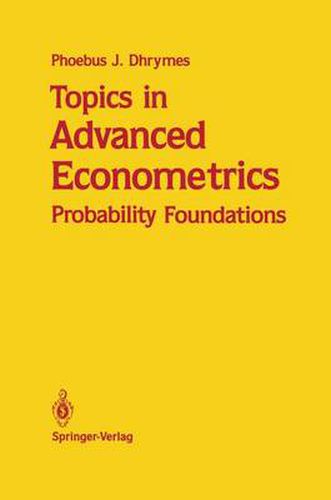Readings Newsletter
Become a Readings Member to make your shopping experience even easier.
Sign in or sign up for free!
You’re not far away from qualifying for FREE standard shipping within Australia
You’ve qualified for FREE standard shipping within Australia
The cart is loading…






This title is printed to order. This book may have been self-published. If so, we cannot guarantee the quality of the content. In the main most books will have gone through the editing process however some may not. We therefore suggest that you be aware of this before ordering this book. If in doubt check either the author or publisher’s details as we are unable to accept any returns unless they are faulty. Please contact us if you have any questions.
For sometime now, I felt that the evolution of the literature of econo metrics had mandated a higher level of mathematical proficiency. This is particularly evident beyond the level of the general linear model (GLM) and the general linear structural econometric model (GLSEM). The problems one encounters in nonlinear econometrics are not easily amenable to treatment by the analytical methods one typically acquires, when one learns about probability and inference through the use of den sity functions. Even in standard traditional topics, one is often compelled to resort to heuristics; for example, it is difficult to prove central limit theorems for nonidentically distributed or martingale sequences, solely by the use of characteristic functions. Yet such proofs are essential, even in only moderately sophisticated classroom exposition. Unfortunately, relatively few students enter a graduate economics de partment ready to tackle probability theory in measure theoretic terms. The present volume has grown out of the need to lay the foundation for such discussions. The motivating forces were, chiefly, (a) the frustration one encounters in attempting to communicate certain concepts to stu dents wholly in analytic terms; and (b) the unwillingness of the typical student to sit through several courses in mathematics departments, in order to acquire the requisite background.
$9.00 standard shipping within Australia
FREE standard shipping within Australia for orders over $100.00
Express & International shipping calculated at checkout
This title is printed to order. This book may have been self-published. If so, we cannot guarantee the quality of the content. In the main most books will have gone through the editing process however some may not. We therefore suggest that you be aware of this before ordering this book. If in doubt check either the author or publisher’s details as we are unable to accept any returns unless they are faulty. Please contact us if you have any questions.
For sometime now, I felt that the evolution of the literature of econo metrics had mandated a higher level of mathematical proficiency. This is particularly evident beyond the level of the general linear model (GLM) and the general linear structural econometric model (GLSEM). The problems one encounters in nonlinear econometrics are not easily amenable to treatment by the analytical methods one typically acquires, when one learns about probability and inference through the use of den sity functions. Even in standard traditional topics, one is often compelled to resort to heuristics; for example, it is difficult to prove central limit theorems for nonidentically distributed or martingale sequences, solely by the use of characteristic functions. Yet such proofs are essential, even in only moderately sophisticated classroom exposition. Unfortunately, relatively few students enter a graduate economics de partment ready to tackle probability theory in measure theoretic terms. The present volume has grown out of the need to lay the foundation for such discussions. The motivating forces were, chiefly, (a) the frustration one encounters in attempting to communicate certain concepts to stu dents wholly in analytic terms; and (b) the unwillingness of the typical student to sit through several courses in mathematics departments, in order to acquire the requisite background.